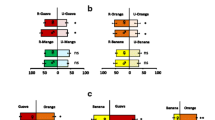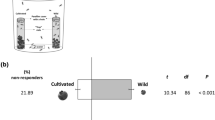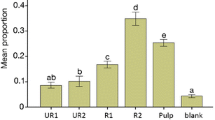Abstract
Frugivorous bats from the Old and New World use odor cues to locate and assess fruit condition. We hypothesized that Egyptian fruit bats (Rousettus aegyptiacus) use as odor cues those volatile compounds that increase in emission rate as fruit ripens. We examined whether the smell of fermentation products may indicate the degree of ripeness to fruit bats. We analyzed volatile compounds in the headspace (the gas space above a fruit in a closed container) of dates (Phoenix dactylifera) and rusty figs (Ficus rubiginosa), both of which are consumed by fruit bats, to elucidate which compounds originate from fermentative pathways and to determine which change in emission rate during ripening. Ethanol, acetaldehyde, and acetic acid were the only volatile compounds detected as products of fermentation in both fruits. In dates, emission rates of these compounds increased during maturation, whereas in rusty figs, they decreased or remained constant. Methanol, although not a fermentation product, increased in emission rate during ripening in both fruits. We found that R. aegyptiacus was neither attracted nor deterred by the smell of methanol at any of the concentrations used. Although the odor of ethanol emanating from food containing concentrations similar to those found in ripe fruit did not attract the bats, at relatively high concentrations (≥1%), the smell of ethanol deterred them. Thus, ethanol at high concentrations may serve as a signal for bats to avoid overripe, unpalatable fruit.



Similar content being viewed by others
References
Acharya, K. K., Roy, A., and Krishna, A. 1998. Relative role of olfactory cues and certain non-olfactory factors in foraging of fruit-eating bats. Behav. Processes 44:59–64.
Black, K. A., Eells, J. T., Noker, P. E., Hawtrey, C. A., and Tephly, T. R. 1985. Role of tetrahydrofolate in the species differences in methanol toxicity. Proc. Natl. Acad. Sci. USA 82:3854–3858.
Boamfa, E. I., Steeghs, M. M. L., Cristescu, S. M., and Harren, F. J. M. 2004. Trace gas detection from fermentation processes in apples; an intercomparison study between proton-transfer-reaction mass spectrometry and laser photoacoustics. Int. J. Mass Spectrom. 239:193–201.
Cosse, A. A., Endris, J. J., Millar, J. G., and Baker, T. C. 1994. Identification of volatile compounds from fungus-infected date fruit that stimulate upwind flight in female Ectomyelois ceratoniae. Entomol. Exp. Appl. 72:233–238.
Dominy, N. J. 2004. Fruits, fingers, and fermentation: the sensory cues available to foraging Primates. Integr. Comp. Biol. 44:295–303.
Dudley, R. 2000. Evolutionary origins of human alcoholism in primate frugivory. Q. Rev. Biol. 75:3–15.
Dudley, R. 2002. Fermenting fruit and the historical ecology of ethanol ingestion: is alcoholism in modern humans an evolutionary hangover? Addiction 97:381–388.
Dudley, R. 2004. Ethanol, fruit ripening, and the historical origins of human alcoholism in primate frugivory. Integr. Comp. Biol. 44:315–323.
Fadda, F. and Rossetti, Z. L. 1998. Chronic ethanol consumption: from neuroadaptation to neurodegeneration. Prog. Neurobiol. 56:385–431.
Fleet, G. H. 2003. Yeast interactions and wine flavour. Int. J. Food Microbiol. 86:11–22.
Fleming, T. H., Haithaus, E. R., and Sawyer, W. B. 1977. An experimental analysis of the food location behavior of frugivorous bats. Ecology 58:619–627.
Frenkel, C., Peters, J. S., Tieman, D. M., Tiznado, M. E., and Handa, A. K. 1998. Pectin methylesterase regulates methanol and ethanol accumulation in ripening tomato (Lycopersicon esculentum) fruit. J. Biol. Chem. 273:4293–4295.
Hoffmann, A. A. and Parsons, P. A. 1984. Olfactory response and resource utilization in Drosophila: interspecific comparisons. Biol. J. Linn. Soc. 22:43–53.
Janzen, D. H. 1977. Why fruits rot, seeds mold, and meat spoils. Am. Nat. 111:691–713.
Kalko, E. K. V., Herre, E. A., and Handley, C. O. 1996. Relation of fig fruit characteristics to fruit-eating bats in the New and Old World tropics. J. Biogeogr. 23:565–576.
Korine, C., Izhaki, I., and Arad, Z. 1999. Is the Egyptian fruit-bat Rousettus aegyptiacus a pest in Israel? An analysis of the bat's diet and implications for its conservation. Biol. Conserv. 88:301–306.
Korine, C. and Kalko, E. K. V. 2005. Fruit detection and discrimination by small fruit-eating bats (Phyllostomidae): echolocation call design and olfaction. Behav. Ecol. Sociobiol. 59:12–23.
Laska, M. 1990. Olfactory sensitivity to food odor components in the short-tailed fruit bat, Carollia perspicillata (Phyllostomatidae, Chiroptera). J. Comp. Physiol. A 166:395–399.
Laska, M. and Schmidt, U. 1986. Olfactory orientation in Carollia perspicillata (Chiroptera). Mamm. Biol. 51:129–138.
Laska, M. and Seibt, A. 2002. Olfactory sensitivity for aliphatic alcohols in squirrel monkeys and pigtail macaques. J. Exp. Biol. 205:1633–1643.
Lefever, G., Vieuille, M., Delage, N., D'harlingue, A., De Monteclerc, J., and Bompeix, G. 2004. Characterization of cell wall enzyme activities, pectin composition, and technological criteria of strawberry cultivars (Fragaria × ananassa Duch). J. Food Sci. 69:221–226.
Lieber, C. S. 2000. Alcohol: its metabolism and interaction with nutrients. Annu. Rev. Nutr. 20:395–430.
Lindinger, W., Hansel, A., and Jordan, A. 1998. On-line monitoring of volatile organic compounds at ppt levels by means of Proton Transfer Reaction Mass Spectrometry (PTR-MS): medical applications, food control and environmental research. Int. J. Mass Spectrom. 173:191–241.
Luft, S., Curio, E., and Tacud, B. 2003. The use of olfaction in the foraging behaviour of the golden-mantled flying fox, Pteropus pumilus, and the greater musky fruit bat, Ptenochirus jagori (Megachiroptera: Pteropodidae). Naturwissenschaften 90:84–87.
Makar, A. B. and Tephly, T. R. 1976. Methanol poisoning in the folate-deficient rat. Nature 261:715–716.
Mangas, J. J., Cabranes, C., Moreno, J., and Gomis, D. B. 1994. Influence of cider-making technology on cider taste. Lebensm.-Wiss. Technol. 27:583–586.
Nursten, H. E. 1970. Volatile compounds: the aroma of fruits, pp. 239–268, in A. C. Hulme (ed.). The Biochemistry of Fruits and Their Products. Academic Press, London.
Rieger, J. F. and Jakob, E. M. 1988. The use of olfaction in food location by frugivorous bats. Biotropica 20:161–164.
Rochat, D., Nagnan-Le Meillour, P., Esteban-Duran, J. R., Malosse, C., Perthuis, B., Morin, J. P., and Descoins, C. 2000. Identification of pheromone synergists in American palm weevil, Rhynchophorus palmarum, and attraction of related Dynamis borassi. J. Chem. Ecol. 26:155–187.
Rohan, T. A. 1972. The chemistry of flavor, pp. 57–69, in J. B. Harborne (ed.). Phytochemical Ecology. Proceedings of the Phytochemical Society Symposium No. 8. Academic Press, London.
Sánchez, F., Korine, C., Pinshow, B., and Dudley, R. 2004. The possible roles of ethanol in the relationship between plants and frugivores: first experiments with Egyptian fruit bats. Integr. Comp. Biol. 44:290–294.
Senesi, E., Di Cesare, L. F., Prinzivalli, C., and Lo Scalzo, R. 2005. Influence of ripening stage on volatiles composition, physicochemical indexes and sensory evaluation in two varieties of muskmelon (Cucumis melo L var reticulates Naud). J. Sci. Agric. 85:1241–1251.
Sharaf, A., Ahmend, F. A., and El-Saadany, S. S. 1989. Biochemical changes in some fruits at different ripening stages. Food Chem. 31:19–28.
Shusterman, D., Osterloh, J. D., Ambre, J., Becker, C., Borak, J., Cannella, J., Kipen, H., Jackson, R. J., Rodnick, J., and Wummer, B. A. 1993. Methanol toxicity. Am. Fam. Physician. 47:163–171.
Steeghs, M., Bais, H. P., De Gouw, J., Goldan, P., Kuster, W., Northway, M., Fall, R., and Vivanco, J. M. 2004. Proton-transfer-reaction mass spectrometry as a new tool for real time analysis of root-secreted volatile organic compounds in Arabidopsis. Plant Physiol. 135:47–58.
Supriyadi, S., Suzuki, M., Wu, S. Q., Tomita, N., Fujita, A., and Watanabe, N. 2003. Biogenesis of volatile methyl esters in snake fruit (Salacca edulis, Reinw) cv. Pondoh. Biosci. Biotechnol. Biochem. 67:1267–1271.
Tucker, G. A. 1993. Introduction, pp. 1–51, in G. B. Seymour, J. E. Taylor, and G. A. Tucker (eds.). Biochemistry of Fruit Ripening. Chapman & Hall, London.
Utrio, P. and Eriksson, K. 1977. Volatile fermentation products as attractants for Macrolepidoptera. Ann. Zool. Fenn. 14:98–104.
Vidrih, R. and Hribar, J. 1999. Synthesis of higher alcohols during cider processing. Food Chem. 67:287–294.
Zar, J. H. 1999. Biostatistical Analysis. Prentice Hall, Upper Saddle River, NJ.
Acknowledgments
We thank A. Zabari, A. Fennec, and R. Glukhikh for their help capturing and maintaining the bats and to Prigat International Ltd. for contributing mango juice. We also thank two anonymous reviewers for constructive comments. Support by US–Israel Binational Science Foundation grant number 2001038 to C.K., B.P., and R.D., a stipend and a student research grant from the Mitrani Department of Desert Ecology (MDDE) to F.S., and a grant from the European Community, Access to Research Infrastructure–Improving Human Potential Programme to F.S. are gratefully acknowledged. This is paper number 571 of the MDDE.
Author information
Authors and Affiliations
Corresponding author
Rights and permissions
About this article
Cite this article
Sánchez, F., Korine, C., Steeghs, M. et al. Ethanol and Methanol as Possible Odor Cues for Egyptian Fruit Bats (Rousettus aegyptiacus). J Chem Ecol 32, 1289–1300 (2006). https://doi.org/10.1007/s10886-006-9085-0
Received:
Revised:
Accepted:
Published:
Issue Date:
DOI: https://doi.org/10.1007/s10886-006-9085-0




